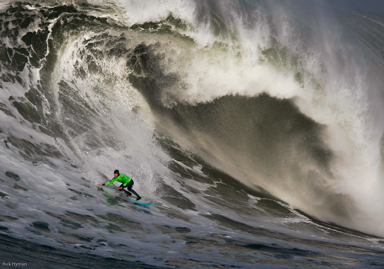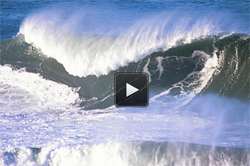Surfing Mavericks: The Science of Northern California's Big Waves
When Mavericks' unusual sea floor terrain meets up with the perfect winter weather conditions rolling in from the Pacific Ocean, the surf's right for big waves. Students can learn more about the area's extreme surf with a range of hands-on science investigations.

In January, daredevil surfers and fans of extreme surfing gathered along Pillar Point, just outside of Half Moon Bay, CA, for Mavericks Invitational. It was the first time in three years that conditions were right to hold the event.
The surf break, which gets its name from the dog that tagged along with a trio of surfers who first decided the break wasn't surfable, was surfed solo by Jeff Clark for more than a decade before other big wave surfers gave the break a try. Winter storms in the Pacific Ocean create big waves at Mavericks, swells that often crest well over 25 feet and create a surfing challenge unlike any other.
Today, Mavericks has developed the kind of notoriety often heaped upon X-game-type sporting events. Since the annual Mavericks surf contest began, there have been both deaths and injuries, and only the elite are invited to brave the waves in an epic showdown that pits surfers against the biggest surf the Northern California coast has to offer. The mystique surrounding Mavericks is steep. The dynamics of the rocky ocean floor can be punishing. The force of the swell cannot be underestimated. This is not your ordinary big wave surfing.
One online surf guide describes Mavericks as "a cold heavy water wave, breaking over a punishing rock bottom with shifting currents [and] visited by great white sharks." Even for Hawaii's legendary big wave surfers, Mavericks is a watery beast of its own.
Though yearly in concept, the date of the Mavericks event varies. These are diehard surfers, but for the surf to be right, the conditions have to be perfect, and the contest window is open for only a few months in the winter. Once meteorological reports and ocean projections pinpoint the timing, a select group of surfers are invited for a surf contest that may happen as quickly as 24-48 hours later. Despite the short notice, the competition draws upwards of fifty thousand spectators and is webcast live.
Ocean Sciences, Math, Physics, and More
You can learn more about big waves in the KQED QUEST video (above). Or, catch big waves on the big screen with movies like Chasing Mavericks (2012, PG)
When you make a map of the mountains and valleys, for example, of an area, you are mapping the topography of the land or the surface contours of the Earth. Bathymetry is a similar study of the depth of the ocean floor. Using bathymetry, contour maps are created that show the terrain of the ocean bottom. In the case of Mavericks, bathymetry studies reveal an unusual underwater ramp bordered by deep troughs on each side. The specifics of the ocean bottom in this area create a scenario of angles, speeds, and bending waves that result in the large, powerful, and unique Mavericks wave. For oceanographers, these waves are a fascinating example of the ways in which the ocean bottom, the weather up top, and laws of physics and math all come to play in wave formation.
Student Making Science Connections
Students interested in Mavericks, ocean sciences, or even extreme surfing, can learn more about related topics in the following science Project Ideas:
- Roaming Robots: Build Your Own Underwater Robot: Underwater data is gathered from a range of sources and techniques, but students curious about Mavericks can learn more about underwater robots that may be used to gather data about the ocean floor. The "Roaming Robots: Build Your Own Underwater Robot" Project Idea guides students in building and testing a simple DIY bot using familiar household or basement materials.
- The Science Behind Tsunamis: Study the Effect of Water Depth on Wave Velocity: What do Mavericks and Tsunamis have in common? Big waves, of course! But both also share velocity. The slope of the sea floor in the area of Mavericks is related to the way the energy of the waves are channeled to the shore. In this science project, students explore the relationship between ocean depth and wave speed.
- Ocean Currents: Modeling the 'Global Conveyor Belt' in Your Kitchen: Bathymetry has a lot to do with why Mavericks big waves are possible, but the "perfect" conditions event organizers watch for each year depend on certain weather conditions, the convergence of meteorological happenings that begin far from shore. In this science project, students explore the relationship between the channels of differing temperatures in the ocean and the velocity of ocean currents.
- Catch the Wave!: In this energy and power project, students use online ocean buoy data to determine possible coastal locations that could be used to harness wave energy as an alternative energy power system. What could a day of Mavericks-sized waves power (besides surfer enthusiasm)?
You may not ever "catch" a Mavericks wave. But with a bit of hands-on science, you can better understand what's going on both under the water and at the top as the waves roll in!
Categories:
You Might Also Enjoy These Related Posts:
- Plastics and Earth Day - Science Projects
- Arduino Science Projects and Physical Computing
- 10+ Robotics Projects with the BlueBot Kit
- 5 STEM Activities with Marshmallow Peeps
- March Madness Basketball Science Projects: Sports Science Experiments
- Women in STEM! More than 60 Scientists and Engineers for Women's History Month
- Explore Artificial Intelligence and Machine Learning with Student AI Projects
- 10 Reasons to Do the Rubber Band Car Engineering Challenge










